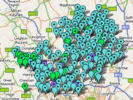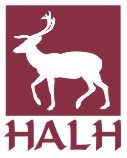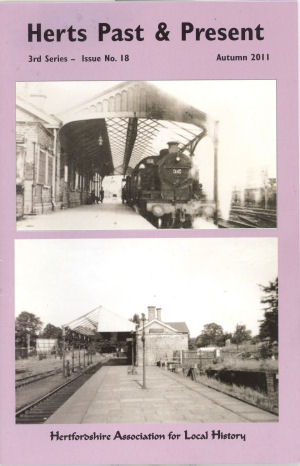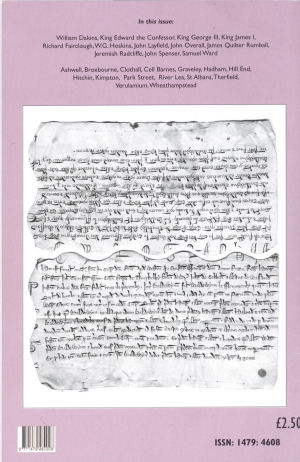This series of mini biographies of the Hertfordshire men who worked on the translations for the King James Bible takes us back to Jacobean Hertfordshire and the lives of eight scholarly priests. Jeremiah Radcliffe, Richard Fairclough and WilIiam Dakins were Hertfordshire born and five others, John Layfield, Francis Burleigh, John Spencer, John Overall, and Samuel Ward had links with Hertfordshire towns and villages. Learned men who shared in the work of translating from the Latin, Hebrew and Greek, many combined distinguished academic careers with a plethora of priestly appointments. One died after being imprisoned in his Cambridge college during the Civil Wars and one sailed to the New World as chaplain to the Earl of Cumberland.
|
|
Herts Past and Present Hertfordshire Association for Local History Autumn 2011 - No 18 |
|
|
In this issue William Dakins, King Edward the Confessor, King George III, King James I, Richard Fairclough, W G Hoskins, John Layfield, John Overall, James Quilter Rumball, Jeremiah Radcliffe, John Spenser, Samuel Ward Ashwell, Broxbourne, Clothall, Cell Barnes, Graveley, Hadham, Hill End, Hitchin, Kimpton, Park Street, River Lea, St Albans, Therfield, Verulamium, Wheathampstead
|
Brief Guide to Sources: Feet of Fines - by David Short |
|
|
Wheathampstead 1060 AD: Bounds: entirely south of the River Lea - by Victor S. White |
||
|
Victor White here offers a fresh reading of the earliest document held at HALS, the 1060 chirograph of Edward I concerning his gift of the manor at Hwaethamstede to St Peter's Westminster. Comparing this to information about the same manor in Domesday 1086 raises some interesting questions about changes in the manorial, later the parish, boundary. This unique Anglo Saxon charter was last discussed in Hertfordshire Past, issue 4, Spring, 1978 in an article by Dr Ian Freeman. 1060AD Wheathampstead/Westminster Land Transfer Hegaestanestone Domesday Book Entry for Kimpton - half Hundred of Hitchin Domesday values, Lay Subsidy 1307 and 1334 Land Boundary: Wheathampstead/Westminster Land Transfer of 1060 AD Bounds: Entirely South of the Lea: Indented, co-incident with Wheathampstead Parish |
||
|
The Hertfordshire men who translated the King James Bible - by Richard N. W Lambert |
||
|
This series of mini biographies of the Hertfordshire men who worked on the translations for the King James Bible takes us back to Jacobean Hertfordshire and the lives of eight scholarly priests. Jeremiah Radcliffe, Richard Fairclough and WilIiam Dakins were Hertfordshire born and five others, John Layfield, Francis Burleigh, John Spencer, John Overall, and Samuel Ward had links with Hertfordshire towns and villages. Learned men who shared in the work of translating from the Latin, Hebrew and Greek, many combined distinguished academic careers with a plethora of priestly appointments. One died after being imprisoned in his Cambridge college during the Civil Wars and one sailed to the New World as chaplain to the Earl of Cumberland. Jeremiah Radcliffe of Hitchin Priory Richard Fairclough of Weston William Dakins, born in Ashwell John Layfield: Rector of Graveley and traveller to the New World Francis Burley, Rector at Thorley and Bishops Stortford John Spenser, Vicar at Broxbourne, 1592 John Overall, Rector at Therfield (1603) and Clothall (1605) Samuel Ward, Rector at Great Munden (1616-1636) See Review |
||
|
'The Abbey Flyer': a history of St Albans Abbey station' - by Peter s. Richards |
||
|
'The Abbey F/yer' is the popular name for the branch railway line of six miles 32 chains between Watford Junction (as distinct from Watford High Street) and St A/bans Abbey stations. These days it is a shuttle service, but until 1924 the station was just known as St A/bans. When it became part of the newly created London Mid/and Steam Railway (LMSR) company it was renamed St A/bans Abbey to distinguish it from St A/bans City, the main line station built by the Midland Railway ten years after the Abbey station. This line was authorized in 1853 to replace a more ambitious scheme of 1847 and opened on 5 May 1856.2 Until May 1858 the only connection to a railway for St Albans residents was a journey by means of stagecoach, horse and chaise or on horseback to Hatfield, to join the Great Northern Railway there, which had been opened some years previously. A grand day out Opposition Downgraded today Earlier proposals The siting of stations St Albans Station facilities prior to 1966 Trouble with time No trains on Sunday Mark Huish, an able railway administrator The twentieth century and electrification The future |
||
|
Unfit for general society: A history of mental health care in Hertfordshire - by Gary Moyle |
||
|
As Gary Moyle remarks, Hertfordshire is notable for the many mental hospitals within its borders. Here he offers an overview of the care of mentally ill from the fourteenth century to the present, showing how responsibility has passed from the Crown to the community, via the parish and private asylums. Along the way he notes those humanitarians, such as William Tuke, whose efforts improved conditions for the afflicted. Introduction Medieval history Old Poor Law Madhouses Acts of Parliament and the county asylums National Health Services Conclusion |
||
|
Also editorial, news items, dates for the diary, and book reviews |




